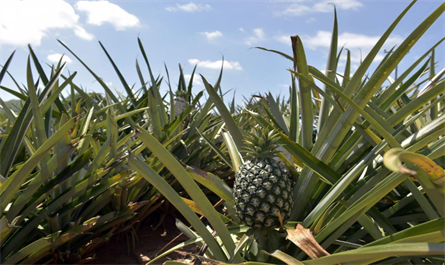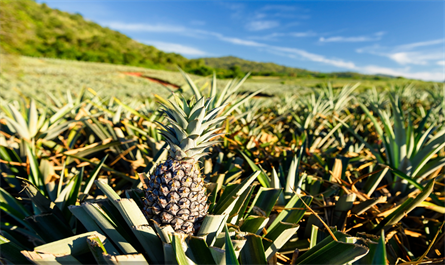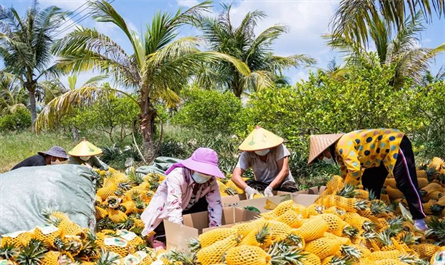Application of plant growth regulators on fruits plantation-Pineapple
Application of plant growth regulators on fruit trees ---- pineapple
Gibberellin and naphthalene acetic acid (sodium) were mixed with fertilizer
1. After bolting the pineapple and the middle and late flowering of the fruit, the leaf surface is sprayed for the first time, and the dosage per 667m² is 3g gibberellin +6.7g naphthalene acetic acid (sodium)+1.7kg urea +2000L water, that is, the concentration of gibberellin is about l7mg/L and the concentration of naphthalene acetic acid (sodium) is about 30mg/L;
2. Spray the fruit for a second time after 15 days, that is, at the early stage of small fruit expansion. The dosage per 667m² is 3.3g gibberellin +10g naphthalene acetic acid (sodium)+3.3kg urea +1.7kg potassium sulfate +0.7kg magnesium sulfate +2000L water;
3. 15d after the second spray, that is, the middle stage of small fruit expansion, spray the third time, and the dosage per 667m² is 10g naphthalene acetic acid (sodium)+3.3kg urea +3.3kg potassium sulfate +1kg magnesium sulfate +2000L water


4,Use Pinsoa brand pineapple king
(1) Single usage amount
(2)Application in different periods
It can promote the absorption of nutrient elements and promote the expansion of fruit, and the average annual production increase is 19.36% ~ 27.87%.


Artificial germination
Since pineapple is a cross-pollinated plant, generally self-flowering is not fruitful, so the production does not use seeds to propagate, and the number of buds produced by each mother plant is limited, and a single plant subgeneration of 5 to 6 plants, only accounting for about 20% of the whole plant dormant buds, so the need for artificial bud promotion.
Ethephon test showed that ethephon treated with 25 ~ 75mg/L had a better effect, and the number of buds increased significantly after treatment.
Control flowering and fruit grow
In order to supply the pineapple market by stages and batches, reduce the losses caused by harvesting in high temperature season and improve economic benefits, artificial flower promotion can be carried out to shorten the growth cycle.
ethephon
1. Fill each plant with 30-50ml of 250-500mg /L of ethephon
2. Use 250mg/L of ethephon + 2% of urea 50ml to make pineapple bud.
Note: The concentration of ethephon should be flexible according to the specific conditions, and the concentration should be low when the temperature is high, on the contrary, the high concentration should be used in the low temperature season.
Naphthalene acetic acid (sodium) With 15 to 20 mg/L of naphthalene acetic acid (sodium) each plant of 50ml, can promote the flowering of pineapple.
Promote fruit expansion
Use Pinsoa brand Pineapple king, its not only can expanding the fruit to improve the production, but aslo balance the sweetness and sour, improve taste, and increase pineapple sugar and fruit weight.


Gibberellin is usually sprayed twice with gibberellin
1. For the first time, spray 50mg/L of gibberellin in the middle of the flower opening.
2. The second time is to spray 70mg/L of gibberellin after the fall of flowers, which can significantly increase the yield and delay the maturity for 7 ~ 10d.
Naphthalene acetic acid (sodium) is generally sprayed with naphthalene acetic acid or sodium naphthalene acetate 2 times, and the application time is the same as gibberellin. The first concentration was 100mg/L, and the second concentration was 200mg/L.
Special attention: Since naphthalene acetic acid or naphthalene acetic acid (sodium) sodium has a significant inhibitory effect on buds, if the liquid drops to the leaf axilla or small suction buds when spraying, it will lead to early bud extraction, making the fruit smaller, so special attention should be paid to the application.
Ripening
use ethephon
1. The ripening fruit ripens uniformly, with uniform coloring and good flesh color.
The use concentration is generally 500 ~ 1000mg/L, and the concentration and treatment time should be based on the weather and fruit maturity.
Note: Fruit maturity should be more than 70% to ripen, that is, when the peel from green to green bean green is the most appropriate time to use, spray should be evenly sprayed to the fruit surface, to spray wet fruit surface is appropriate.
Gibberellin and naphthalene acetic acid (sodium) were mixed with fertilizer
1. After bolting the pineapple and the middle and late flowering of the fruit, the leaf surface is sprayed for the first time, and the dosage per 667m² is 3g gibberellin +6.7g naphthalene acetic acid (sodium)+1.7kg urea +2000L water, that is, the concentration of gibberellin is about l7mg/L and the concentration of naphthalene acetic acid (sodium) is about 30mg/L;
2. Spray the fruit for a second time after 15 days, that is, at the early stage of small fruit expansion. The dosage per 667m² is 3.3g gibberellin +10g naphthalene acetic acid (sodium)+3.3kg urea +1.7kg potassium sulfate +0.7kg magnesium sulfate +2000L water;
3. 15d after the second spray, that is, the middle stage of small fruit expansion, spray the third time, and the dosage per 667m² is 10g naphthalene acetic acid (sodium)+3.3kg urea +3.3kg potassium sulfate +1kg magnesium sulfate +2000L water


4,Use Pinsoa brand pineapple king
(1) Single usage amount
| Pineapple king dosage | Water consumption |
| Dosage/acre | L/acre |
| 0.7-0.8 | 950-1000 |
| 1.4-1.6 | 950-1000 |
| 2.1-2.4 | 950-1000 |
| Pineapple king dosage | Water consumption | Application period |
| L/acre | L/acre | Flower/fruit stage |
| 0.7-0.8 | 950 | In bloom |
| 0.7-0.8 | 950 | After flowering 10-14 days |


Artificial germination
Since pineapple is a cross-pollinated plant, generally self-flowering is not fruitful, so the production does not use seeds to propagate, and the number of buds produced by each mother plant is limited, and a single plant subgeneration of 5 to 6 plants, only accounting for about 20% of the whole plant dormant buds, so the need for artificial bud promotion.
Ethephon test showed that ethephon treated with 25 ~ 75mg/L had a better effect, and the number of buds increased significantly after treatment.
Control flowering and fruit grow
In order to supply the pineapple market by stages and batches, reduce the losses caused by harvesting in high temperature season and improve economic benefits, artificial flower promotion can be carried out to shorten the growth cycle.
ethephon
1. Fill each plant with 30-50ml of 250-500mg /L of ethephon
2. Use 250mg/L of ethephon + 2% of urea 50ml to make pineapple bud.
Note: The concentration of ethephon should be flexible according to the specific conditions, and the concentration should be low when the temperature is high, on the contrary, the high concentration should be used in the low temperature season.
Naphthalene acetic acid (sodium) With 15 to 20 mg/L of naphthalene acetic acid (sodium) each plant of 50ml, can promote the flowering of pineapple.
Promote fruit expansion
Use Pinsoa brand Pineapple king, its not only can expanding the fruit to improve the production, but aslo balance the sweetness and sour, improve taste, and increase pineapple sugar and fruit weight.


Gibberellin is usually sprayed twice with gibberellin
1. For the first time, spray 50mg/L of gibberellin in the middle of the flower opening.
2. The second time is to spray 70mg/L of gibberellin after the fall of flowers, which can significantly increase the yield and delay the maturity for 7 ~ 10d.
Naphthalene acetic acid (sodium) is generally sprayed with naphthalene acetic acid or sodium naphthalene acetate 2 times, and the application time is the same as gibberellin. The first concentration was 100mg/L, and the second concentration was 200mg/L.
Special attention: Since naphthalene acetic acid or naphthalene acetic acid (sodium) sodium has a significant inhibitory effect on buds, if the liquid drops to the leaf axilla or small suction buds when spraying, it will lead to early bud extraction, making the fruit smaller, so special attention should be paid to the application.
Ripening
use ethephon
1. The ripening fruit ripens uniformly, with uniform coloring and good flesh color.
The use concentration is generally 500 ~ 1000mg/L, and the concentration and treatment time should be based on the weather and fruit maturity.
Note: Fruit maturity should be more than 70% to ripen, that is, when the peel from green to green bean green is the most appropriate time to use, spray should be evenly sprayed to the fruit surface, to spray wet fruit surface is appropriate.
RECENT POSTS
-
Comprehensive analysis of the various factors that need to be considered in growing pineapples
-
The key steps of pineapple cultivation include soil selection, sowing, management and pest control
-
What effect does S-abscisic acid have on grapes?
-
Application of plant growth regulators in cherry farming
Featured News



